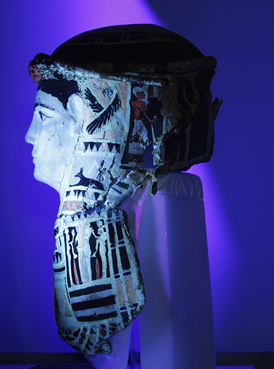The Hearst Museum of Anthropology at the University of California-Berkeley has an exhibit running now through May 11, 2011 that presents Egyptian artifacts including crocodile mummies, statuary, mummy portraits, amulets, and stela.
 The artifacts, collected through the patronage of Phoebe A. Hearst around 1900, have been treated with a variety of advanced conservation techniques designed to preserve them for future generations.
The artifacts, collected through the patronage of Phoebe A. Hearst around 1900, have been treated with a variety of advanced conservation techniques designed to preserve them for future generations.
Conserving and Presenting Archaeological Artifacts
One of the challenges faced by archaeologists and museum personnel is that most artifacts are made out of materials that break down, decompose, or disintegrate over time.
This is most obvious with items made out of wood, plant fibers, or animal products, but it is also true of artifacts made of metal, glass, and even stone.
The preservation of artifacts in the archaeological record is influenced by a variety of factors, like soil composition, climate, rainfall, environmental disturbance, and how protected the artifact is.
For instance, it is fairly common to find wooden and cloth artifacts in Egyptian tombs because the dry climate inhibits the growth of bacteria and the structure of the tomb itself protects the artifacts.
Once artifacts have been removed from their archaeological context, they are exposed to new environments that can speed up their decomposition.
Conservation techniques have been developed by museums to slow down or completely stop the breakdown of archaeological materials.
These techniques have evolved over time and practices that were once thought of as cutting-edge protections are now known to be ineffective or damaging to the artifacts they were supposed to protect.
This requires the development of new techniques to fix the damage done in the past and to further protect artifacts for future study and presentation.
“The Conservator’s Art” Exhibit
This exhibit, then, both presents the Egyptian artifacts and showcases the Museum’s preservation efforts.
One of the most intriguing parts of the exhibit is that Allison Lewis, Samuel H. Kress Conservation Fellow, is conserving Egyptian artifacts in the Gallery during the exhibition and is available to answer questions and explain the techniques used in the exhibit.
She is also keeping a blog that details what techniques have been used on what artifacts and why, including before and after pictures for many of the conserved artifacts.
This behind-the-scenes look at the process of conserving artifacts adds an important dimension to the exhibit.
Details
“The Conservator’s Art: Preserving Egypt’s Past” exhibit at the Phoebe A. Hearst Museum of Anthropology on the UC-Berkeley campus runs through May 11.
The museum is open Wednesday to Saturday 10:00am - 4:30pm and Sunday 12:00pm - 4:00pm.
Allison Lewis is present in the gallery 10:30 am - 4:30 pm Wednesdays through Fridays. Admission to the museum is free.
Author: Emma Bate | Source: Examiner [January 04, 2011]